8 Reasons You’re Completely Wrong About the Star Wars Prequels
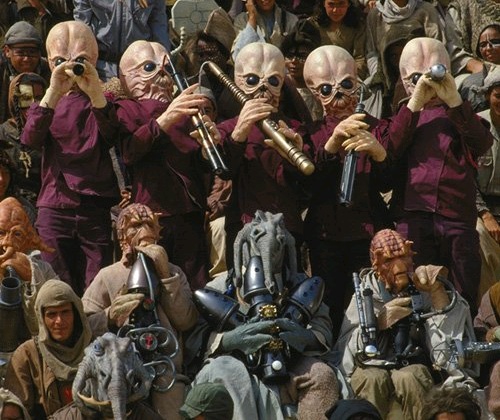 |
Normally, I don’t think it’s necessary to write about or deeply examine the kind of enjoyment ones gets out of movies like Star Wars. It rarely pays. But I’m fascinated and a little horrified by the general response to George Lucas’s prequel trilogy these days. The Internet has deputized (or militarized or radicalized) a strange breed of I/O fruitcakes who, at least in public, believe that expressing one’s feelings with the least possible nuance is the best way to go every time. In truth, anywhere in America it’s hard to find sixty people who will agree about anything except about how much they hate something. And yet check out any AICN talkback to hear an unexamined criticism savagely confirmed, dissent level zero: “The Hobbit movies are just cash grabs! The English Patient is boring! I would not sleep with that famously beautiful actress if she begged me! Hurrah!”
And yet this hate for these Star Wars prequels is something deeper. There is a fervent madness to it, such absolute agreement from so many, and all incredibly misguided. Groupthink is toxic negativity that dignifies nobody. That said, in the spirit of negativity and nattering nabobs, here are eight bulletproof pro-prequel arguments that I think only a Sith could deny.
1. You’re Throwing Out the Baby With the Bathwater.
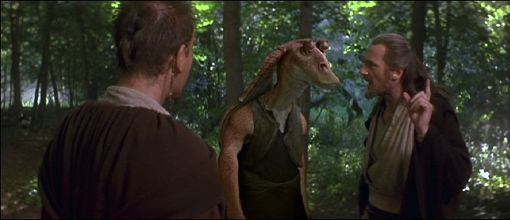 |
You are. And there’s this metaphorical bathwater just about anywhere you look, everywhere in life. Nothing is perfect. And the more ambitious something is, the less chance it can ever be anything close to perfect. In cases like these, concessions must be made. It goes without saying that many movies are a lot closer to perfect than any of the Star Wars films. Annie Hall, which beat Star Wars for best picture in 1977, is almost perfect, but then again Annie Hall does not take place in a setting completely made up from whole cloth. It all has to do with your approach as a viewer. Your finances, you should nit-pick. Star Wars movies, you should try to enjoy. And remember, Lucas and his chosen guys had to make up all of the stuff in those movies. So going around looking for evidence of failure, and then being smug about it, is being a bit of spoilsport.
The Star Wars prequels are stuffed-to-bursting with cool details and scenes and characters worth discussing in eager approval, and yet to my surprise the very generation weaned on Lucas’s visionary ’70s goof-off are indeed fixated only on the aspects that plain don’t work, of which there aren’t many and about which I’ll state the obvious: Nobody is arguing with you that Jar Jar is too front-and-center in The Phantom Menace. He’s a mostly misjudged character. C-3PO worked better as an audience proxy. And neither is anyone advocating the idea that Lucas is particularly good at communicating with his actors, or that they always seem “in” on whatever it is he’s trying to get across: The very talented Natalie Portman seemed to perpetually have trouble in this regard. She’s being asked to play someone who was a politician before she was even an adult, and it feels like Lucas didn’t quite bring out the best in her. Even Hayden Christensen, who still seems perfect for the part, is allowed to land at least few bum line readings in each picture.
But, but, but…older actors like Liam Neeson and Alec Guinness can and do fill those gaps in with panache, if only because they are automatically familiar with the size of the thing Lucas is asking for, and the tone. I think you have to at least know who Charles Laughton is to be able to pull this stuff off. And you can take that same algorithm and apply it to the whole series under Lucas: Where his eccentric and loaded intent is best displayed, as with the visual storytelling, results are generally peerless. The man can and did fill a movie screen with the kind of transporting wonder that makes popcorn seem like prime rib. His weak areas have always been his weak areas, but is that what we should be focusing on when the man is practically the Michelangelo of album-cover style fantasy imagery?
Art historian Camille Paglia argues that the last 30 minutes of Sith is the greatest single work of art by anyone of the last fifty years, and while nobody I know including myself would go that far, one would have to assume that Paglia must have some sort of an interesting take on art history, since she’s famous for doing so and makes a nice living. It should at least give one pause, and be cause for possible re-evaluation. And yet these strange angry voices dig in ever harder, hatred rocketing as they contemplate elitism and engage in the open discussion of causing George Lucas bodily harm. And that’s pathological, because Lucas would seem to have earned more respect years ago, and because I see in the prequels three of the very best movies of their type of the last 20 or so years (most of the rest are by Peter Jackson), and I think that fact is frankly obvious.
All that good stuff is the clean little baby, and the negative stuff goes in the bathwater and down the drain because nothing is perfect, and even babies get dirty. It seems to me that many of these angry voices are holding their dirty babies to the sky and demanding rain.
2. Movies Are a Visual Medium.
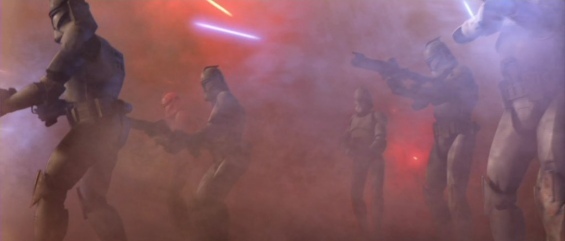 |
I like Quentin Tarantino ‘s movies a whole lot, and I think he singlehandedly minted a lot of new film fans, but it seems a lot of those newcomers then became convinced that funny and real-sounding dialogue was the most important thing in any movie. So any time one of them discovered even a single moment that wasn’t self-aware, or wasn’t founded entirely on post-1992 conventions, the B.S. alarm rang. (Ever heard one of these people say “I don’t care about pretty pictures; what I care about is plot!”? Is it somehow easier to come up with jaw-dropping and convincing CG imagery than it is to borrow someone’s copy of a screenwriting guide?)
But the even greater director Robert Altman often said disparagingly that most movies were just “filmed theater.” In other words, the movies were written and made as if theater with faster and more dynamic scene changes was the only goal. Think about most movies. Often, indeed what we see are scenes of people talking and interacting, then a cut to a different geographical place, followed by more talking and interacting. But it makes no sense at this point to use so little of film’s real potential and power. Movies have the close-up, the tableau shot, the arts of cinematography and editing. Those things are not available in books or theater, and so it would seem movies have a duty to tell different kinds of stories than can be told in those older mediums. This is why someone like Terrence Malick gets so many people bowing at his feet, and I’m one of them. He uses imagery to tell his story, getting the most out of the medium.
And so does George Lucas, much more so in the prequels, since CG had allowed his visual imagination to go wild. For instance, we have things like the marvelous moment in Phantom Menace when the creaky old battle droid transport shows up on the field of war, and out comes rack after rack of folded-up, battered-up robot warriors. (The fact that they’re not cutting it as an army anymore is, of course, the platform the bad guys use to sell the Republic on the clones.) Then there’s the celebrated sequence as tension grows in Sith that has Anakin and Padme look in each others directions, from opposite skyscrapers, across a great dusky swath of their city-planet. This image, besides being striking in composition, is also what I mean by visual storytelling. The prequels are stuffed, end-to-end, with that kind of loaded imagery, and also with very gripping scenes of action and Sturm und Drang heavy derring-do.
These are the things you should be worrying about during a Star Wars movie, much more than the front-and-center acting and/or dialogue. It would be great if these were all really great actors reading really strong dialogue, but such failure is not lethal in a movie like this. The opposite would be true in a John Cassavetes or mumblecore movie, where the performances and natural-sounding dialogue are the most important parts. Nothing is perfect. Attack of the Clones doesn’t have great acting or naturalistic dialogue, but A Woman Under The Influence is certainly lacking in the department of imaginary spacy-fantasy vistas and sci-fi swordfights.
3) The Story is More Interesting in the PT than in the OT.
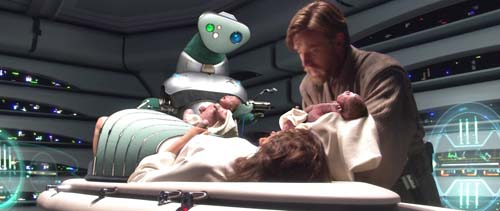 |
It’s not just the damn hero’s journey again. I’ve had my share of the hero’s journey. Seriously? We, who are so very impressed with our own complexity, are okay with “there’s really only one story”? I’ll bet there’s more than one story. Oh, here’s one: the villain’s journey. It’s a reflective story. In it, on a properly adolescent level, Lucas questions his own involvement with the gung-ho martial enthusiasm that any war movies – set on earth or not – can’t help but generate. So we have Anakin Skywalker, who is unavoidably too flawed already by his anger long before he is taken away from his mother. And Liam Neeson’s Qui-Gon, so excited about his potential finding of The Chosen One that he can’t understand that he’s wrong. And Obi-Wan, too inexperienced himself to do anything but watch helplessly as his pupil descends into ego, all before a self-satisfied and complacent Jedi council.
Then there’s the aspect of the two space virgins, one a skilled politician more than an experienced human, the other a righteously ego-filled major dude who is actively missing the point of his obviously Eastern-based Jedi training. And the backdrop for all of that is some very nasty pop-political machinations that are certainly a mirror of their times. And don’t give me crap about “trade federation meetings are boring,” as there is nothing of that sort in the actual movie. That’s just in the title crawl, and you’re just being difficult.
4) The Presence of CG Itself is Neither Here Nor There.
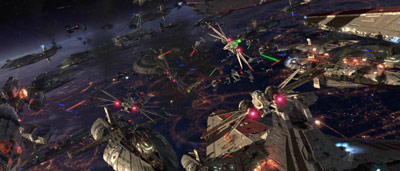 |
Plenty of good movies have been made with tons of the stuff, and plenty without. It’s not the substance of CG work itself that’s the problem, but rather the soul in it. CG stuff is only as good as the work that goes into it. But the promise of CG was mostly in two things: real-looking dinosaurs to chase us through mad-marvelous sci-fi worlds. The CG element of the prequels is often a point of attack for the angry ones, and their argument usually amounts to “they look too busy”. By this they mean there’s too much stuff going on there in the image. Again, this criticism is rooted in anger at Lucas’s ’97 revisions, because the prequels were dreamed up on that scale – in fact, to satisfy that scale – and everything on-screen is interesting.
When characters in the prequels could be standing against a white wall while talking, instead there are some out-of-focus CG aliens cruising around WAAAAAAY in the back and down a hall. This is there to convince you how deep this world goes, to establish that there’s something going on around the corner that we’re not privy to. And if you’re telling me that there’s too much interesting stuff happening in the corners of the frame, that doesn’t seem like a criticism to me but rather the stuff of a rewarding rewatch. What they used to call “an embarrassment of riches”. Just think of it like when they shoot a movie in New York City: You’re not really watching what everyone is doing in the back, are you? Watch the people in front is my tip.
5) They’re More Consistently Engaging Than 99% of Big Summer Blockbusters We’ve had Since..
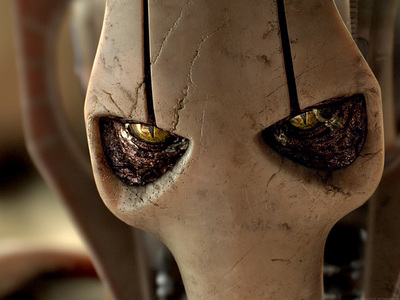 |
By engaging, I mean I actually achieve lift-off as a viewer. That’s the aim of any movie, but especially so with escapism. As I get into the movies, I no longer am worrying about if every little moment of the film is another golden footprint on the path to perfection. This seems pretty subjective, of course, and it is, but for example, the final 30 minutes of The Phantom Menace is truly sublime escapism. The lightsaber battle (2 good guys vs. 1 bad guy, which you never see) is the stuff of 1979 dreams, and three other building climaxes are intercut very skillfully. I particularly like the idea of the little kid (Jake Lloyd, otherwise an admitted weak link) with the big powers flying a star-fighter into the stratosphere to help take down the giant station that controls the shopworn battle droids, who themselves are doing battle with an army of aliens who are fighting them off with those cool-looking blue orbs that go boom.
Anyway, that’s a description of how I see last act of Menace. Here’s the last act of last summer’s Man of Steel: The aliens show up with their very predictable looking post-Giger “terraformers” (talk about a done-to-death WMD), and Superman fights General Zod, and they knock each other through buildings until ten minutes is up and no paying audience could conceivably argue they didn’t “get enough”; then the bad guy still-more-predictably forces the good guy’s hand in delivering us the necessary killing blow. The killing blow is apparently necessary even in a story about a guy who doesn’t kill people. Which sounds better to you? I’m well aware the answer for some of you is Superman, but it can’t be all of you. Star Wars is and has been an extension of Lucas’ affection for the escapism of his own youth, and his movies know how to make such silliness convincing by keeping things zippy and inventive moment-to-moment, like most good movies of the type from the ’30s to the ’50s. Man of Steel is a product of that product, too many times removed, with no actual organic connection to the good stuff. It’s like eating a picture of a sandwich.
6) Only George Lucas Can Make Star Wars.
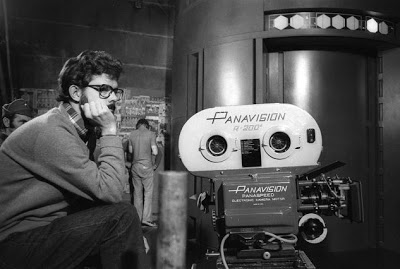 |
The best films have always, and I’ll bet will always, come closest to the ideal of the auteur theory. A book or a painting is nearly the pure product of just one writer and an idea or a tone. The individuality of one person, the undiluted idea, can be expressed clearly. We know where to look. Movies aren’t always like that, but time and again, from Titanic to Tokyo Story, the best and most beloved movies are the ones that are the closest to having been made with one person in control, that spring forth from the individuality of that one person (with some help in the particulars). Not everyone is particularly interesting when it comes to dreaming up imaginary worlds, but George Lucas is momentously gifted in the conceptual department of space-fantasy scenarios. He’s able to focus on escapism with the same work ethic that other filmmakers would reserve for more serious work.
Put simply, what’s good and special about Star Wars IS George Lucas, in the same way that the early Disney films feel especially informed by Walt Disney himself. The opposite of this situation is the kind of thing we see most often these days: movies made by committee where enough uninteresting people are allowed to get their hands on a picture and scrub it free of anything resembling artistic intent. And so you get a movie like this year’s Godzilla, where someone seems to have actively removed any element that anyone else behind the scenes might have been passionate about. Did you find yourself wondering why the story for that picture was so rote? Someone intentionally made it that way. Is the assumption that foreign audiences need to see bland crap? Nobody likes bland crap, not even the execs who force it before us. This is the kind of surreal confusion that satirists dream of.
7) Despite Your Vested Interest, You Weren’t the Intended Audience
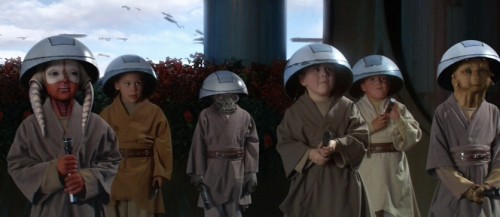 |
This is an easy one. I know how much we all loved Star Wars when we were kids, and of course we’re going to have a rooting interest when Lucas comes back and makes a new one after 15 years. But these movies are made for kids.
Not for dumb kids, like some of this stuff, but for smart kids, smart adolescents and the occasional imaginative grown-up. When we were all young we didn’t see Star Wars as a movie that could have been better or could have been worse. The overriding thought wasn’t, “I should have these people’s jobs, ’cause I could do it way better”. No, we saw what was happening on the screen and that was that. What happened happened, and wasn’t that something? But pile on twenty years of adult living and adult regrets, heartbreak, disillusionment? You’ve got a 35-year-old man who can no longer be satisfied by the primary colors of even the best movies for adolescents, and needs rather to focus more on works for adults that reflect this shading. And, no, The Dark Knight does not count. So go watch Scenes From A Marriage (it’s as satisfying to an adult as Lucas is to a kid), but don’t go out in public raving that the kiddie space adventure movies raped your childhood. Something else raped your childhood, pal, and it was the rest of your life.
8) Kids Love Them
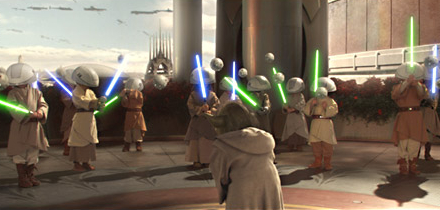 |
I don’t have kids yet, so maybe that’s a factor, but there are two kids I know and love very much, one girl and one boy, and they are nuts for Star Wars. All of Star Wars, all six, and they don’t seem to have a particular preference for the older trilogy. It’s all Star Wars. I recently got one of them the coolest Anakin-into-Vader dolls, where you drop the helmet over the sculpt of Hayden Christensen and the heavy breath effect kicks in. I didn’t foist it on the kid, mind you; this was what the boy wanted. His folks bought him a Clone Trooper costume, and the kid wears it around town with the same straight-face he has wearing a cowboy outfit or serviceman green. His older sister, a brilliant child, is the only girl I know who is planning to go as Darth Vader this year for Halloween.
These kids are lucky because they get to just enjoy the whole series, and they’re the ones Lucas made those questionable ’97 changes to the OT for. These kids will never understand the unbelievably pervasive disgust people my age tend to have for the prequel episodes. And in this case the kids will be right, because they don’t lead with cynicism. It would never occur to them. For a grown-up, it’s harder to see the forest for the trees. This world earns our cynicism. But it’s worth noting that bad vibes are no more representative of the whole truth than sentimentality. Both are worthwhile frames of mind, both with their appropriate moments.
Here is a moment to be uncynical: For Christmas last year, one of them painted me the below as gift. I was thrilled to get it. (His sister had been painting me great expressionist portraits of the Universal movie monsters for a few years already.)
 |
| From left: Qui-Gon, Obi-Wan, Darth Maul. |
 |
| (This is obviously Darth Maul.) |
Notice how they’re smiling? He knows these are enemies in the movies. He gets it. But he’s just so happy about it all. His father and I had a momentary discussion about that element of his son’s painting, and I know we agreed on why that was or might have been. I honestly don’t recall what our reasoning was, but I remember being a kid, and somewhere I know why it makes sense for them to be smiling through their most desperate battles.

